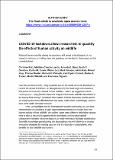Files in this item
COVID-19 lockdown allows researchers to quantify the effects of human activity on wildlife
Item metadata
| dc.contributor.author | Rutz, Christian | |
| dc.contributor.author | Loretto, Matthias-Claudio | |
| dc.contributor.author | Bates, Amanda E. | |
| dc.contributor.author | Davidson, Sarah C. | |
| dc.contributor.author | Duarte, Carlos M. | |
| dc.contributor.author | Jetz, Walter | |
| dc.contributor.author | Johnson, Mark | |
| dc.contributor.author | Kato, Akiko | |
| dc.contributor.author | Kays, Roland | |
| dc.contributor.author | Mueller, Thomas | |
| dc.contributor.author | Primack, Richard B. | |
| dc.contributor.author | Ropert-Coudert, Yan | |
| dc.contributor.author | Tucker, Marlee A. | |
| dc.contributor.author | Wikelski, Martin | |
| dc.contributor.author | Cagnacci, Francesca | |
| dc.date.accessioned | 2020-12-22T00:37:39Z | |
| dc.date.available | 2020-12-22T00:37:39Z | |
| dc.date.issued | 2020-06-22 | |
| dc.identifier | 268643792 | |
| dc.identifier | f9620f9e-f06e-493e-bef9-fb19e9c3f48e | |
| dc.identifier | 85086463241 | |
| dc.identifier | 000545238200002 | |
| dc.identifier.citation | Rutz , C , Loretto , M-C , Bates , A E , Davidson , S C , Duarte , C M , Jetz , W , Johnson , M , Kato , A , Kays , R , Mueller , T , Primack , R B , Ropert-Coudert , Y , Tucker , M A , Wikelski , M & Cagnacci , F 2020 , ' COVID-19 lockdown allows researchers to quantify the effects of human activity on wildlife ' , Nature Ecology and Evolution . https://doi.org/10.1038/s41559-020-1237-z | en |
| dc.identifier.issn | 2397-334X | |
| dc.identifier.other | RIS: urn:F656A2AA6025F04F4B749387232D989B | |
| dc.identifier.other | RIS: Rutz2020 | |
| dc.identifier.other | ORCID: /0000-0001-5187-7417/work/76386987 | |
| dc.identifier.uri | https://hdl.handle.net/10023/21185 | |
| dc.description | Funding: Manuscript preparation was supported through: a Radcliffe Fellowship at the Radcliffe Institute for Advanced Study, Harvard University (to C.R.); the European Union’s Horizon 2020 research and innovation programme under the Marie Skłodowska-Curie grant agreement no. 798091 (to M.-C.L.); and Autonomous Province of Trento ordinary funds to Fondazione Edmund Mach (to F.C.). | en |
| dc.description.abstract | Reduced human mobility during the pandemic will reveal critical aspects of our impact on animals, providing important guidance on how best to share space on this crowded planet. | |
| dc.format.extent | 4 | |
| dc.format.extent | 5698459 | |
| dc.language.iso | eng | |
| dc.relation.ispartof | Nature Ecology and Evolution | en |
| dc.subject | GE Environmental Sciences | en |
| dc.subject | GF Human ecology. Anthropogeography | en |
| dc.subject | QH301 Biology | en |
| dc.subject.lcc | GE | en |
| dc.subject.lcc | GF | en |
| dc.subject.lcc | QH301 | en |
| dc.title | COVID-19 lockdown allows researchers to quantify the effects of human activity on wildlife | en |
| dc.type | Journal item | en |
| dc.contributor.institution | University of St Andrews. Centre for Biological Diversity | en |
| dc.contributor.institution | University of St Andrews. School of Biology | en |
| dc.contributor.institution | University of St Andrews. Sea Mammal Research Unit | en |
| dc.identifier.doi | https://doi.org/10.1038/s41559-020-1237-z | |
| dc.description.status | Peer reviewed | en |
| dc.date.embargoedUntil | 2020-12-22 |
This item appears in the following Collection(s)
Items in the St Andrews Research Repository are protected by copyright, with all rights reserved, unless otherwise indicated.

